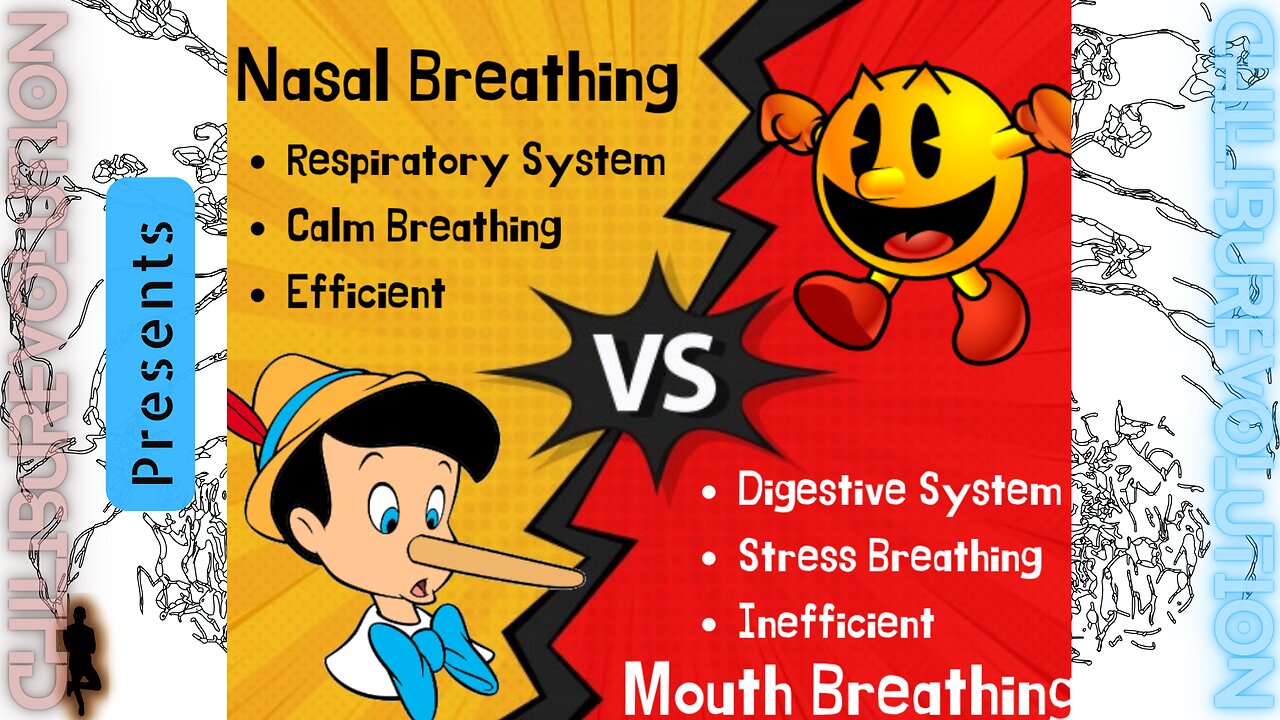Premium Only Content

Nasal Breathing VS Mouth Breathing
THE HEALTH BENEFITS OF NASAL BREATHING
Your nose is designed to help you breathe safely, efficiently, and properly. It can do this due to its ability to:
-Filter out foreign particles. Nasal hair filters out dust, allergens, and pollen, which helps prevent them from entering your lungs.
-Humidify inhaled air. Your nose warms and moisturizes the air you breathe in. This brings the air you inhale to body temperature, making it easier for your lungs to use.
-Produce nitric oxide. During nasal breathing, your nose releases nitric oxide (NO). NO is a vasodilator, which means it helps to widen blood vessels. This can help improve oxygen circulation in your body.
Mouth breathing
Your mouth helps you eat, drink, and talk. You can also use your mouth to breathe, but it doesn’t have many of the unique features that your nose has for this purpose.
Yet, breathing primarily through your mouth is associated with some health risks. With mouth breathing, your mouth loses moisture, which can cause dry mouth. It could also increase your risk of:
-inhaling unfiltered air
-allergic reactions to allergens
-asthma
-bad breath
-tooth decay
-gum inflammation (gingivitis)
-snoring
-sleep apnea
-teeth or jaw abnormalities
Breathing through the nose is the way our bodies were designed. In fact, it’s been said that breathing through your mouth is about as practical as trying to eat through your nose!
According to experts, most people breathe at 10-20 percent of their full capacity. Restricted breathing greatly decreases respiratory function, which in turn decreases energy levels in the body.
Since oxygen is our main source of life, and exhalation is the main way to expel toxins from our bodies, poor breathing can contribute to a multitude of health problems, from high blood pressure to insomnia.
Poor breathing may even contribute to some forms of cancer: In 1931, Otto Warburg won a Nobel Prize for determining that only oxygen-starved cells will mutate and become cancerous. That should be proof enough to learn how to breathe properly!
Many of us feel stressed out, overworked, and overstimulated during our daily lives, which leaves us in a chronic state of fight or flight response. Breathing in and out through the nose helps us take fuller, deeper breaths, which stimulates the lower lung to distribute greater amounts of oxygen throughout the body.
Also, the lower lung is rich with the parasympathetic nerve receptors associated with calming the body and mind, whereas the upper lungs — which are stimulated by chest and mouth breathing — prompt us to hyperventilate and trigger sympathetic nerve receptors, which result in the fight or flight reaction.
Copyright info:
* We do not own the rights to all content. They have, in accordance with fair use, been repurposed with the intent of educating and inspiring others.
* We must state that in NO way, shape or form am I intending to infringe rights of the copyright holder. Content used is strictly for research/reviewing purposes and to help educate. All under the Fair Use law.
* We don't own any copyright concerning the extracts used in this video. But we allow myself to use them in order to help people in motivational form.
-
 1:30
1:30
Mind, Body & Soul
6 months ago90 Second Nudge
933 -
 1:22:29
1:22:29
Dr. Drew
1 day agoJenny McCarthy: After Son's Near-Death Reaction & Autism Diagnosis, Star Fights For Safer Childhood Vaccines w/ Alison Morrow – Ask Dr. Drew
52.6K12 -
 LIVE
LIVE
bigbossrobinson
5 hours agoLIVE - STRAIGHT INTO HELL - HELLDIVERS 2
97 watching -
 9:30
9:30
MattMorseTV
4 hours ago $2.47 earnedWe just got the CONFIRMATION.
11.7K21 -
 20:04
20:04
World2Briggs
3 hours ago $0.58 earnedTop 10 States That Are Getting Worse Every Year
8.83K1 -
 LIVE
LIVE
Quite Frankly
6 hours ago"Jumbotron Affair, Customer Service & 24hr America, Haunted Objects" 7/17/25
710 watching -
 LIVE
LIVE
LFA TV
23 hours agoLFA TV ALL DAY STREAM - THURSDAY 7/17/25
686 watching -
 LIVE
LIVE
WickedVirtue
7 hours agoIs Pop Culture Dying? Reboot Fatigue & The Creative Crisis -Wicked's World #65
74 watching -
 1:39:56
1:39:56
Redacted News
4 hours agoBOMBSHELL EPSTEIN NEWS ABOUT TO HIT, MOSSAD TIES EXPOSED
172K200 -
 19:21
19:21
Preston Stewart
4 hours ago $0.33 earnedSyria Back To War
7.51K1